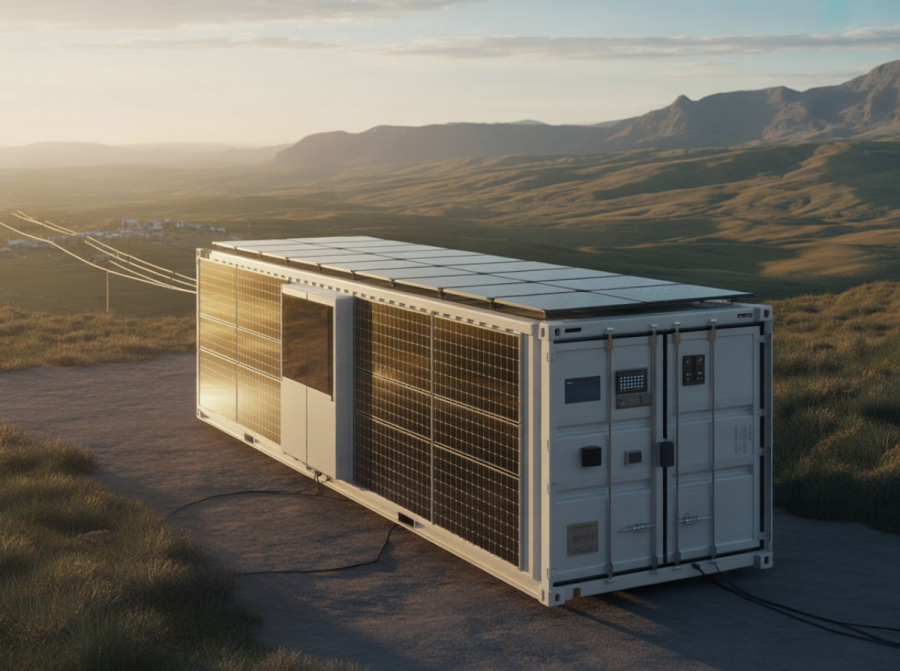The Rise of Mobile Solar Containers
In a world facing growing energy demands and intensifying climate challenges, access to clean, reliable, and mobile power sources has become essential. While traditional grid infrastructure struggles to reach remote regions, technological innovation is bridging the gap, and at the heart of this evolution lies the mobile solar container.
These portable energy systems are redefining how renewable power is deployed, offering flexibility, sustainability, and efficiency for off-grid and temporary applications. From disaster response operations to rural electrification and industrial use, mobile solar solutions are unlocking new possibilities for a world in transition toward cleaner energy.
Understanding the Concept of a Mobile Solar Container
A mobile solar container is a fully integrated, transportable power generation and storage unit designed to harness solar energy. Built inside a standard shipping container, it includes photovoltaic panels, inverters, batteries, and a management system, all preassembled and ready for immediate deployment.
Unlike fixed solar installations that require lengthy construction, permits, and site preparation, these systems are plug-and-play, allowing users to start generating clean electricity within hours of arrival. This flexibility makes them ideal for temporary or remote projects where speed and reliability are paramount.
How It Works
- Solar Energy Capture – Solar modules mounted on or within the container absorb sunlight and convert it into direct current (DC).
- Energy Conversion – An inverter converts the DC power into alternating current (AC) to run standard electrical systems.
- Energy Storage – Integrated batteries store excess electricity for use during cloudy weather or nighttime.
- Distribution – A built-in controller manages power flow, ensuring efficient distribution between generation, storage, and consumption.
This design ensures continuous power generation, even in the most isolated or challenging environments.
Advantages of Mobile Solar Containers
Mobile solar technology brings together portability, scalability, and sustainability. Below are the core benefits driving its global adoption.
1. Rapid Deployment
Pre-engineered and pre-tested, these units can be delivered and activated in a fraction of the time it takes to set up a traditional solar system. For emergency relief or off-grid construction projects, this fast setup is invaluable.
2. Portability and Flexibility
Because they’re built into standard shipping containers, mobile solar systems can be easily transported by truck, rail, or ship to virtually any location. Once deployed, they can be relocated as needs change, a major advantage for temporary camps or rotating industrial sites.
3. Reliable Off-Grid Power
In regions with unstable or non-existent grid connections, mobile solar systems provide a dependable and sustainable power supply. They’re particularly beneficial for hospitals, schools, and communication hubs operating in off-grid regions.
4. Sustainable and Eco-Friendly
Mobile solar containers operate without fossil fuels, eliminating greenhouse gas emissions and noise pollution associated with diesel generators. They also reduce dependency on fuel logistics, cutting long-term operational costs.
5. Scalable Design
Multiple units can be linked together to create modular microgrids, scaling power generation as demand increases. This makes them ideal for growing communities, military bases, or industrial operations requiring flexible capacity.
Applications Across Industries
The versatility of mobile solar systems allows them to serve a wide variety of sectors. Here are some of the most impactful use cases:
Humanitarian and Disaster Relief
In the aftermath of natural disasters, electricity is often the first and most urgent need. Mobile solar containers can be airlifted or trucked to disaster zones, providing instant power for emergency shelters, medical centres, and communication systems.
Rural Electrification
For remote villages in Africa, Asia, and Latin America, extending national power grids can be prohibitively expensive. Mobile solar systems offer an affordable and scalable alternative, enabling communities to power homes, schools, and local businesses sustainably.
Construction and Mining Operations
Industrial operations in remote areas often rely on diesel generators, which are costly to operate and maintain. Containerised solar systems provide a cleaner, quieter, and more efficient power source for machinery, site lighting, and worker facilities.
Military and Field Operations
Defence organisations increasingly use mobile solar technology to power bases and communication systems without revealing their positions through generator noise or heat signatures.
Events and Temporary Installations
From outdoor festivals to film productions, mobile solar units provide an eco-friendly alternative to diesel-powered setups, combining clean energy with easy transport and installation.
Technology Behind Mobile Solar Systems
The innovation driving mobile solar containers lies in their smart integration of components and automation technologies.
High-Efficiency Solar Panels
Modern systems use monocrystalline or bifacial solar panels that capture sunlight more efficiently, producing maximum power output in compact spaces.
Advanced Battery Storage
Integrated lithium-ion or LiFePO₄ batteries ensure a continuous power supply, storing excess energy during the day and discharging it when needed.
Smart Control Systems
Digital management tools allow users to monitor energy generation, storage status, and consumption remotely through mobile apps or web dashboards.
Robust Container Design
The structure is weather-resistant, equipped with ventilation, insulation, and anti-corrosion coatings to ensure longevity even in extreme climates.
Hybrid Integration
Some systems can be combined with other renewable energy sources, such as wind or hydro, to create fully hybrid, self-sustaining energy ecosystems.
Environmental and Economic Impact
Environmental Benefits
- Zero Emissions: Mobile solar systems produce clean electricity without burning fossil fuels.
- Reduced Noise Pollution: Unlike diesel generators, they operate silently, making them suitable for residential and environmental zones.
- Minimal Land Disruption: Installation requires no permanent infrastructure or excavation.
- Circular Design: Using repurposed containers promotes material reuse and reduces manufacturing waste.
Economic Advantages
- Lower Operational Costs: Once installed, sunlight is free, reducing fuel expenses dramatically.
- Job Creation: Promotes local employment in system assembly, deployment, and maintenance.
- Energy Independence: Users can generate their own power, shielding themselves from grid instability and fuel price volatility.
These combined benefits make mobile solar technology both environmentally and financially sustainable.
The Role of Mobile Solar Technology in the Energy Transition
The global transition toward renewable energy relies not only on large-scale solar farms but also on decentralised, mobile systems that deliver power anywhere it’s needed. Mobile solar containers embody this flexibility, bridging gaps in infrastructure and accelerating clean energy adoption.
They are particularly important in developing nations where grid coverage is still expanding. Governments, NGOs, and private investors are recognising their potential to meet sustainability targets and support United Nations Sustainable Development Goal 7, Affordable and Clean Energy for All.
By democratizing access to renewable power, mobile solar systems are empowering communities and industries to participate in the green economy on their own terms.
Future Outlook
Looking ahead, the evolution of mobile solar technology will centre on increased efficiency, automation, and connectivity.
Key trends to watch include:
- AI-Driven Power Management: Predictive analytics to optimise energy flow based on usage patterns and weather conditions.
- Lighter, Flexible Panels: Reducing weight for easier transportation and faster setup.
- Hydrogen Integration: Storing excess solar energy in hydrogen form for extended off-grid autonomy.
- Smart Microgrids: Interconnected solar containers forming intelligent, adaptive networks.
- Energy-as-a-Service Models: Leasing mobile solar units to businesses and communities for scalable, low-cost renewable access.
As innovation continues, mobile solar containers will play an increasingly vital role in sustainable development, humanitarian work, and corporate decarbonization.
To Conclude
The mobile solar container represents one of the most transformative technologies in the renewable energy sector today. It merges the reliability of solar power with the flexibility of modular design, making clean electricity accessible anywhere on Earth.
From powering disaster relief zones to enabling rural electrification and supporting industrial operations, these self-contained systems are helping create a world where mobility and sustainability go hand in hand.
As the clean energy movement accelerates, mobile solar technology will remain at the forefront of innovation, driving resilience, efficiency, and equity in global power access.
Share It on :





